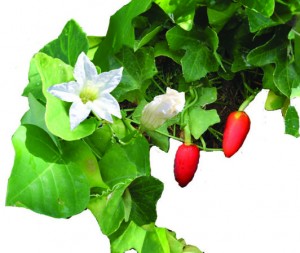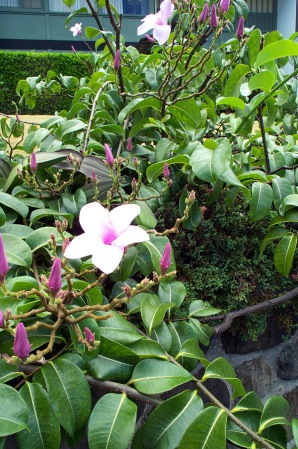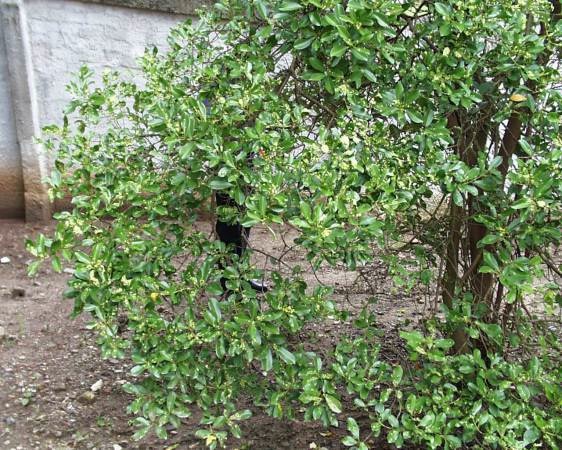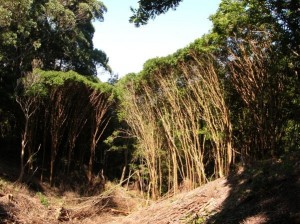
Ivy gourd can be identified by the 5-petaled flowers and green fruit that turn red as they ripen, hanging like Christmas lights from the plant. Photo by MISC
On Maui, we are lucky to have so many open spaces. Our island is relatively undeveloped, though you may beg to differ when you’re stuck in traffic. The majority of the population lives along the coastlines. This distribution of island residents is nearly identical to the distribution of ivy gourd; a highly invasive vine found growing in central, south, and west Maui. And, as development expands, so does the population of ivy gourd. This is no coincidence.
Native to Africa, India, and Southeast Asia, ivy gourd was probably brought to the Hawaiian Islands by an immigrant from one of those areas. The immature fruit of the plant, as well as the young shoots, are used in cooking. Many recipes from Southeast Asia call for ivy gourd. While it may taste good in a stir fry, it’s in poor taste—illegal even—to have the plant growing in your yard.
Inevitably, the vine escapes cultivation. Humans—and their pesky rodent counterparts—have been the vectors for spreading ivy gourd. Rats scamper off with a stolen fruit spreading the seeds. In absence of the insect pests that limit ivy gourd’s growth in its native habitat, the plant grows unchecked. Roots form every time the branching vine touches the ground. Each root is enlarged, giving ivy gourd the ability to survive lengthy periods of drought.
Ivy gourd, Coccinia grandis, can be hard to identify without the flower or fruit present. The leaves are broad and flat, shaped like an angular heart, about 2.5 inches wide. They are arranged in an alternating pattern along the vine. The flower is white, with 5 petals curving out of a tube-like base. If the plant reaches the fruiting stage, the 3-inch long fruit, dangling like bright red Christmas lights, is a dead giveaway that the vine smothering your yard is ivy gourd.
Ivy gourd is fast-growing. While we don’t know the actual rate of growth on Maui, it is a member of the cucumber family of plants that may grow up to 4 inches a day. If we ignored this aggressive growing vine what would happen? “We’d be ivy gourdians” a 7th grade student so aptly replied during a class visit by MISC. When people don’t consume ivy gourd, ivy gourd consumes the environment around us. Trees, power poles, fences, even cars disappear beneath a mountain of vines.

The fast-growing ivy gourd can easily smother trees, fences, and power lines. It could transform the native dryland ecosystem, choking out rare Hawaiian plants and leaving nothing but curtains of green. Photo by MISC
Ivy gourd is currently limited to residential areas on Maui. MISC’s successful control of the population depends entirely on the cooperation of property owners and residents. Because the vine grows so fast, and because the seeds germinate so quickly after a rain, monthly site visits may be necessary. A plant can go from seedling to seed-bearing within as little as a month, and once the plant produces seed, the seed bank can last for years. Field crews must find and apply a few drops of herbicide to every single root in order to kill the plant, no small task when the plant has covered several kiawe trees.
On the islands of O`ahu and Hawai’i, ivy gourd is invading natural areas. On Guam and Saipan, ivy gourd is so established that the only way to limit it may be through biocontrol. Insect pests have been released in these areas. On Maui, control efforts have reduced ivy gourd to a level that would no longer support a viable biocontrol population. The only way to eradicate it is to get rid of the remaining plants, monitor locations for new plants, and prevent new introductions.
If a plant nursery is infested with ivy gourd, it’s almost inevitable that seeds and plant material will be spread in contaminated soil. This may help explain why we find ivy gourd in golf courses. A huge infestation was discovered on Lāna‘i in 2006, and with continued effort the population is being knocked back.
And those open spaces on Maui? Above the development of Lahaina and Kīhei are the remnants of the native dryland forest ecosystem. The leeward slopes of Haleakalā, where this ecosystem was once predominant, still harbor stands of native trees. This is where ‘iliahi (sandelwood) grows. The wiliwili tree can be found here, as well as the naio trees that gave us the name for the area: Kanaio. These areas have been greatly altered by ranching and the introduction of goats and deer, yet they still include rare native plants and insects. There is no ivy gourd here. Ivy gourd would thrive here if introduced into these native forests. Ivy gourd would smother the existing vegetation, leaving curtains of green where there once were diverse and rare ecosystems.
Help us protect these rare ecosystems on by finding and reporting ivy gourd in Maui’s residential and rural areas. Do not grow ivy gourd. If you suspect you may have ivy gourd on your property, please call the Maui Invasive Species Committee at 573-MISC (6472) and we will remove it, free of charge.








